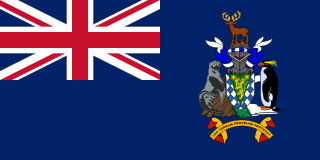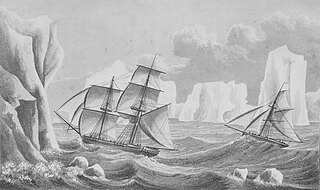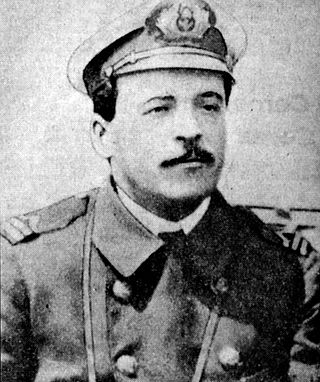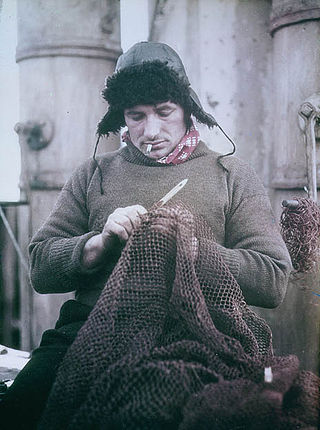
South Georgia and the South Sandwich Islands (SGSSI) is a British Overseas Territory in the southern Atlantic Ocean. It is a remote and inhospitable collection of islands, consisting of South Georgia and a chain of smaller islands known as the South Sandwich Islands. South Georgia is 165 kilometres (103 mi) long and 35 kilometres (22 mi) wide and is by far the largest island in the territory. The South Sandwich Islands lie about 700 kilometres (430 mi) southeast of South Georgia. The territory's total land area is 3,903 km2 (1,507 sq mi). The Falkland Islands are about 1,300 kilometres (810 mi) west from its nearest point.

The history of Antarctica emerges from early Western theories of a vast continent, known as Terra Australis, believed to exist in the far south of the globe. The term Antarctic, referring to the opposite of the Arctic Circle, was coined by Marinus of Tyre in the 2nd century AD.

Grytviken is a hamlet on South Georgia in the South Atlantic and formerly a whaling station and the largest settlement on the island. It is located at the head of King Edward Cove within the larger Cumberland East Bay, considered the best harbour on the island. The location's name, meaning "pot bay", was coined in 1902 by the Swedish Antarctic Expedition and documented by the surveyor Johan Gunnar Andersson, after the expedition found old English try pots used to render seal oil at the site. Settlement was re-established on 16 November 1904 by Norwegian Antarctic explorer Carl Anton Larsen on the long-used site of former whaling settlements.

Elephant Island is an ice-covered, mountainous island off the coast of Antarctica in the outer reaches of the South Shetland Islands, in the Southern Ocean. The island is situated 245 kilometres north-northeast of the tip of the Antarctic Peninsula, 1,253 kilometres west-southwest of South Georgia, 935 kilometres south of the Falkland Islands, and 885 kilometres southeast of Cape Horn. It is within the Antarctic claims of Argentina, Chile and the United Kingdom.

The voyage of the James Caird was a journey of 1,300 kilometres (800 mi) from Elephant Island in the South Shetland Islands through the Southern Ocean to South Georgia, undertaken by Sir Ernest Shackleton and five companions to obtain rescue for the main body of the stranded Imperial Trans-Antarctic Expedition of 1914–1917. Many historians regard the voyage of the crew in a 22.5-foot (6.9 m) ship's boat through the "Furious Fifties" as the greatest small-boat journey ever completed.

Thomas Crean was an Irish seaman and Antarctic explorer who was awarded the Albert Medal for Lifesaving (AM).

The Imperial Trans-Antarctic Expedition of 1914–1917 is considered to be the last major expedition of the Heroic Age of Antarctic Exploration. Conceived by Sir Ernest Shackleton, the expedition was an attempt to make the first land crossing of the Antarctic continent. After Roald Amundsen's South Pole expedition in 1911, this crossing remained, in Shackleton's words, the "one great main object of Antarctic journeyings". Shackleton's expedition failed to accomplish this objective but became recognized instead as an epic feat of endurance.

Frank Arthur Worsley was a New Zealand sailor and explorer who served on Ernest Shackleton's Imperial Trans-Antarctic Expedition of 1914–1916, as captain of Endurance. He also served in the Royal Navy Reserve during the First World War.

Operation Paraquet was the code name for the British military operation to recapture the island of South Georgia from Argentine military control in April 1982 at the start of the Falklands War.

HMS Endurance was a Royal Navy ice patrol vessel that served from 1967 to 1991. She came to public notice when she was involved in the Falklands War of 1982. The final surrender of the war, in the South Sandwich Islands, took place aboard Endurance.

Carl Anton Larsen was a Norwegian-born whaler and Antarctic explorer who made important contributions to the exploration of Antarctica, the most significant being the first discovery of fossils for which he received the Back Grant from the Royal Geographical Society. In December 1893 he became the first person to ski in Antarctica on the Larsen Ice Shelf which was subsequently named after him. In 1904, Larsen re-founded a whaling settlement at Grytviken on the island of South Georgia. In 1910, after some years' residence on South Georgia, he renounced his Norwegian citizenship and took British citizenship. The Norwegian whale factory ship C.A. Larsen was named after him.

Jason was a Norwegian whaling vessel laid down in 1881 by Rødsverven in Sandefjord, Norway, the same shipyard which later built Ernest Shackleton's ship Endurance. The ship, financed by Christen Christensen, an entrepreneur from Sandefjord, was noted for his participation in an 1892–1893 Antarctic expedition led by Carl Anton Larsen.

The history of South Georgia and the South Sandwich Islands is relatively recent. When European explorers discovered the islands, they were uninhabited, and their hostile climate, mountainous terrain, and remoteness made subsequent settlement difficult. Due to these conditions, human activity in the islands has largely consisted of sealing, whaling, and scientific surveys and research, interrupted by World War II and the Falklands War.

Stromness is an abandoned whaling station on the northern coast of South Georgia Island in the South Atlantic. It was the destination of Sir Ernest Shackleton's rescue journey in 1916. It is the central of three harbours in the west side of Stromness Bay, South Georgia.

Luis Alberto Pardo Villalón was a Chilean Navy officer who, in August 1916, commanded the steam tug Yelcho to rescue the 22 stranded crewmen of Sir Ernest Shackleton's ship, Endurance, part of the Imperial Trans-Antarctic Expedition. The crewmen were stranded on Elephant Island, an ice-covered mountainous island off the coast of Antarctica in the outer reaches of the South Shetland Islands, in the Southern Ocean.

John William Vincent was an English seaman and member of Ernest Shackleton's Imperial Trans-Antarctic Expedition. He was one of the five men who accompanied Shackleton on his epic crossing from Elephant Island to South Georgia and was one of only four of the crew of Endurance not to receive the Polar Medal.
Crean Glacier is a glacier 4 miles (6.4 km) long, flowing northwest from Wilckens Peaks to the head of Antarctic Bay on the north coast of South Georgia. It was surveyed by the South Georgia Survey in the period 1951–57 and named by the UK Antarctic Place-Names Committee for Irishman Tom Crean, Second Officer of the Endurance during the British expedition under Ernest Shackleton, 1914–16. Crean accompanied Shackleton and Frank Worsley in the James Caird from Elephant Island to King Haakon Bay, South Georgia, and made the overland crossing with them to Stromness; this glacier lies on the route.

Larsen Harbour is a narrow 2.6 miles (4.2 km) long inlet of indenting volcanic rocks and sheeted dykes known as the Larsen Harbour Formation. It is a branch of Drygalski Fjord, entered 2.5 miles (4 km) west-northwest of Nattriss Head, at the southeast end of South Georgia Island. It was charted by the Second German Antarctic Expedition, 1911–12, under Filchner, who named it for Captain Carl Anton Larsen a Norwegian explorer, who made significant contributions to the exploration of Antarctica. The most significant of these was the first discovery of fossils on the continent, for which he received the Back Grant from the Royal Geographical Society. Larsen is also considered the founder of the Antarctic whaling industry and the settlement and whaling station of Grytviken, South Georgia.
Shackleton Valley is a broad valley running west-northwest from Stromness Harbor, Stromness Bay, in South Georgia. It was named by the United Kingdom Antarctic Place-Names Committee (UK-APC) after Sir Ernest Henry Shackleton, British Antarctic explorer, whose epic traverse of South Georgia with two of his men, in May 1916, following their boat journey from Elephant Island, ended in this valley. They made contact with Mr. Sorlle, the manager at Stromness whaling station, and then set about organizing the rescue of three of their party from King Haakon Bay, South Georgia, and a further group of men marooned on Elephant Island.


















